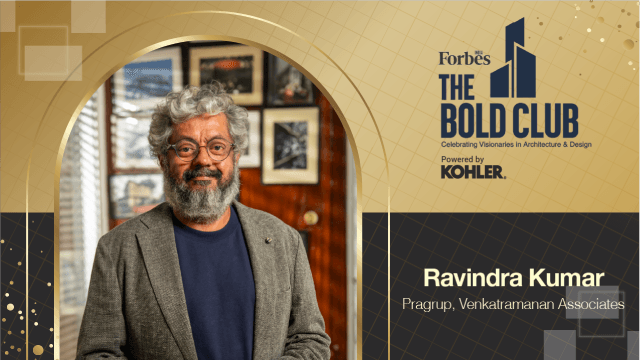
Ravindra Kumar : – Principal Architect and Design Chair – Pragrup, Venkataramanan Associates
Ravindra Kumar is the founder and principal architect of ‘Pragrup’ Architects and a partner and design chair at ‘Venkataramanan Associates.’ Under his mentorship, Pragrup has completed more than 285 national and international projects since its inception in 1999. Kumar finds himself fortunate to associate with esteemed architects and institutes across the world either through academia or practical projects in his formative years, providing inspiration and fueling innovation. His approach to design is rooted in a balance between functionality and technology. His fascination with drawing as a language of architecture extended into construction detailing, ensuring every project was grounded in practicality and feasibility. Looking ahead, Kumar iterates that AI (Artificial Intelligence) can be used as a useful tool to enhance efficiency in data processing, modeling, and visualization, but it lacks the intuitive, emotional, and context-driven aspects of human creativity. Kumar believes that architecture is an ever-evolving field that thrives on learning from the past while envisioning the future. The greatest lesson remains the importance of curiosity, exploration, and continuous refinement.
A formidable name in architecture and urban design, Ravindra Kumar has won numerous accolades in a career that has lasted more than thirty years. He is the founder and principal architect of ‘Pragrup’ Architects and a partner and design chair at ‘Venkataramanan Associates.’ Under his mentorship, Pragrup has completed more than 285 national and international projects since its inception in 1999.
A passion for art and graphic design led Kumar to a diploma in Fine Arts and introduced him to architects who collaborated with him on portfolios, ideas, and project designs. This exposure sparked a curiosity to learn more about the architectural field, leading him to study architecture at Bangalore University. During his formative years in architecture school, Kumar gained practical experience and exposure engaging with architects and facing real-life challenges.
Kumar finds himself fortunate to associate with esteemed architects and institutes across the world either through academia or practical projects in his formative years, providing inspiration and fueling innovation. While studying under Lucho at Permissa, he learned about the technology of building and innovation. Further learning about large-scale building and urban design came through an exchange program for a short-term master’s course at CEPT. Associations with architects such as Paulo Soleri, Glen Market, Vecchia, Philip Cox, and others reinforced the belief that architecture is an evolving discipline, requiring continuous exploration and refinement.
For Kumar, extensive travel, being in new places, and meeting new people are a source of great inspiration for his designs. Observing heritage, vernacular, and contemporary architecture, and associating with architects provided firsthand knowledge and learnings from their experiences. His approach to design is rooted in a balance between functionality and technology. His fascination with drawing as a language of architecture extended into construction detailing, ensuring every project was grounded in practicality and feasibility.
The office of ‘Pragrup’ is an excellent example of Kumar’s commitment to creating technology based sustainable designs. The office is built with the idea of a composite structure using re-engineered and recycled timber and recycled steel. On a larger scale, projects like building a 24-acre ‘Nirlon’ campus over a period of 20 years presented the challenge of maintaining architectural consistency while incorporating cutting-edge sustainability practices. One of Kumar’s earlier endeavors, ‘Lupin Laboratories’, is the most exciting experience which focused on transparency, daylight maximization, and seamless integration with the landscape.
Looking ahead, Kumar iterates that AI (Artificial Intelligence) can be used as a useful tool to enhance efficiency in data processing, modeling, and visualization, but it lacks the intuitive, emotional, and context-driven aspects of human creativity. The nuances of architecture, tied to memory, history, and spatial experience, cannot be entirely replicated by AI.
Kumar believes that architecture is an ever-evolving field that thrives on learning from the past while envisioning the future. The greatest lesson remains the importance of curiosity, exploration, and continuous refinement. Kumar advises young architects and designers to embrace this journey with an open mind that will lead to endless possibilities in shaping the built environment.